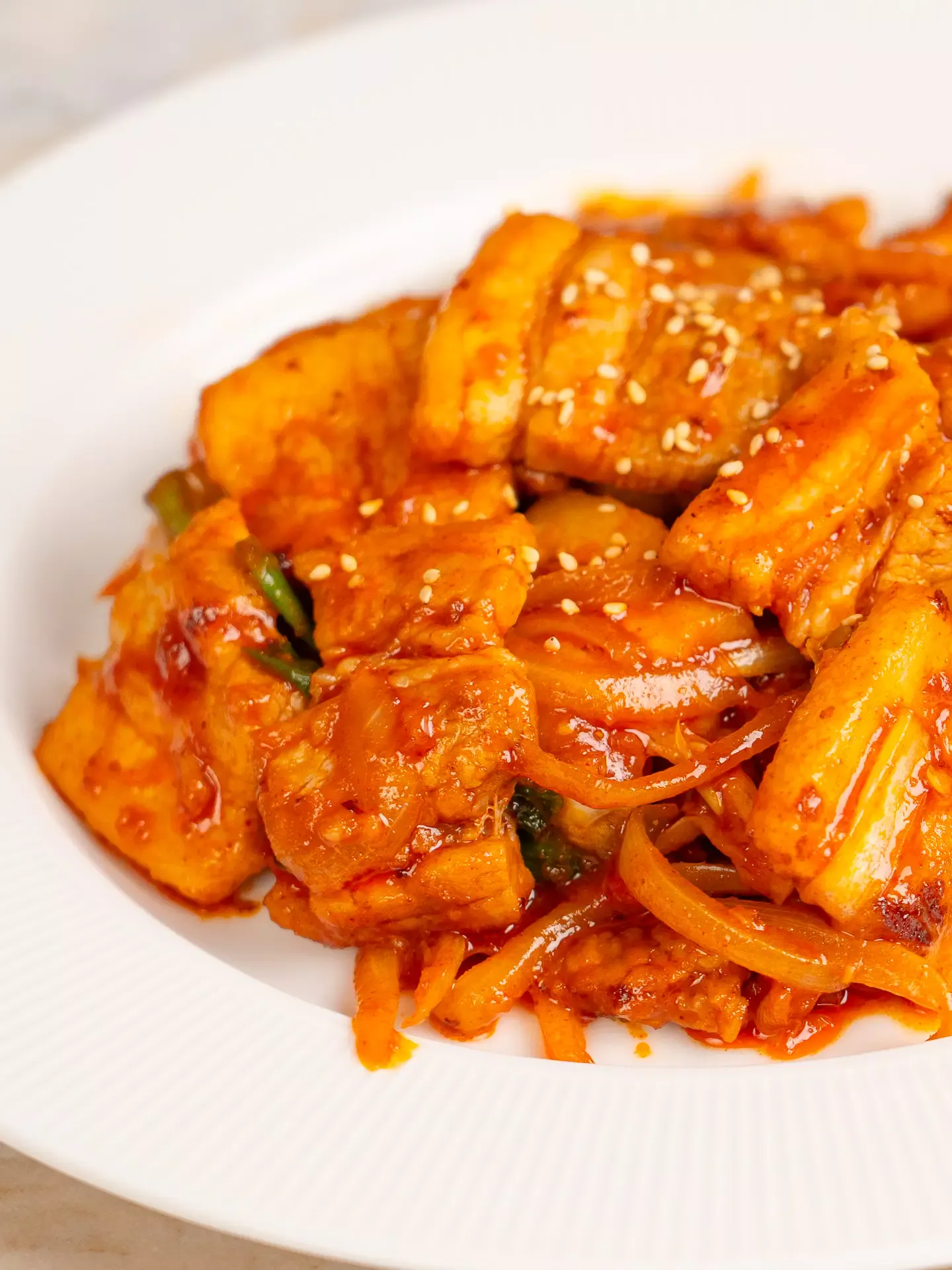Today, I’m sharing a recipe for Jeyuk Bokkeum (제육볶음), the ultimate soul food for Korean men, made in Seoul restaurant style.
We’ll only use two vegetables, and it’s very simple and easy—it’s ready in just 15 minutes.
Even without any other dishes, this spicy pork stir-fry is a complete meal.
Table of Contents
What is Jeyuk Bokkeum?
Jeyuk Bokkeum is a Korean dish that is stir-fried with pork, gochujang (Korean red chili paste), and vegetables.
Popular pork cuts for this dish include pork belly, front leg, shoulder, or hind leg meat. The pork is sliced into bite-sized pieces and stir-fried with a gochujang-based sauce made with soy sauce, sugar, and other seasonings. It is usually cooked with vegetables like onion and green onion.
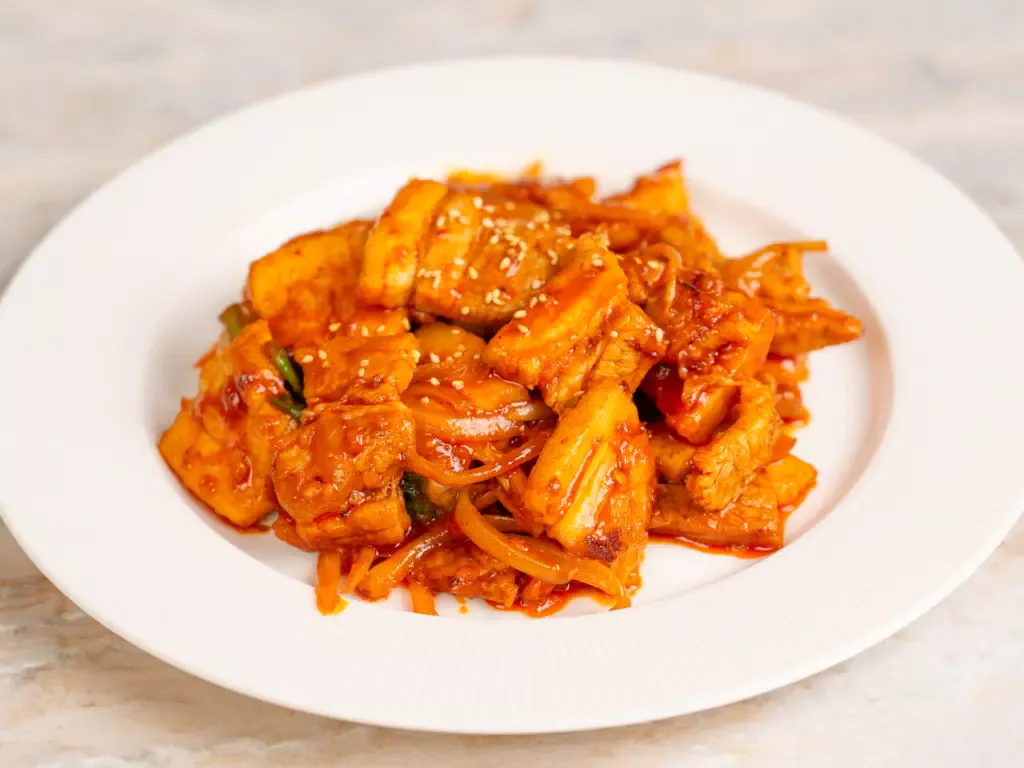
How Koreans Enjoy Jeyuk Bokkeum
Jeyuk Bokkeum is often served with rice as a side dish or wrapped in lettuce as ssam. You can also place it over rice to enjoy it as Jeyuk Deopbap (spicy pork rice bowl). I can confidently say this is one of the most beloved dishes among Korean men. If you ever go to Korea and make Korean male friends, just say, “Let’s go eat Jeyuk Bokkeum.” There’s a 99.99999% chance they’ll say yes.
A Staple Near Universities and Office Areas
This dish is commonly found near universities or office areas in Korea. It’s quick for restaurants to make and easy for customers to eat on the go.
The Perfect Drinking Food with Soju
While it’s often enjoyed as a rice meal, Koreans also love eating Jeyuk Bokkeum as anju (drinking food) with soju. If you visit a Korean pocha (street food bar), you’ll almost always see Jeyuk Bokkeum on the menu. Its spicy, greasy flavor makes it a perfect match for soju.
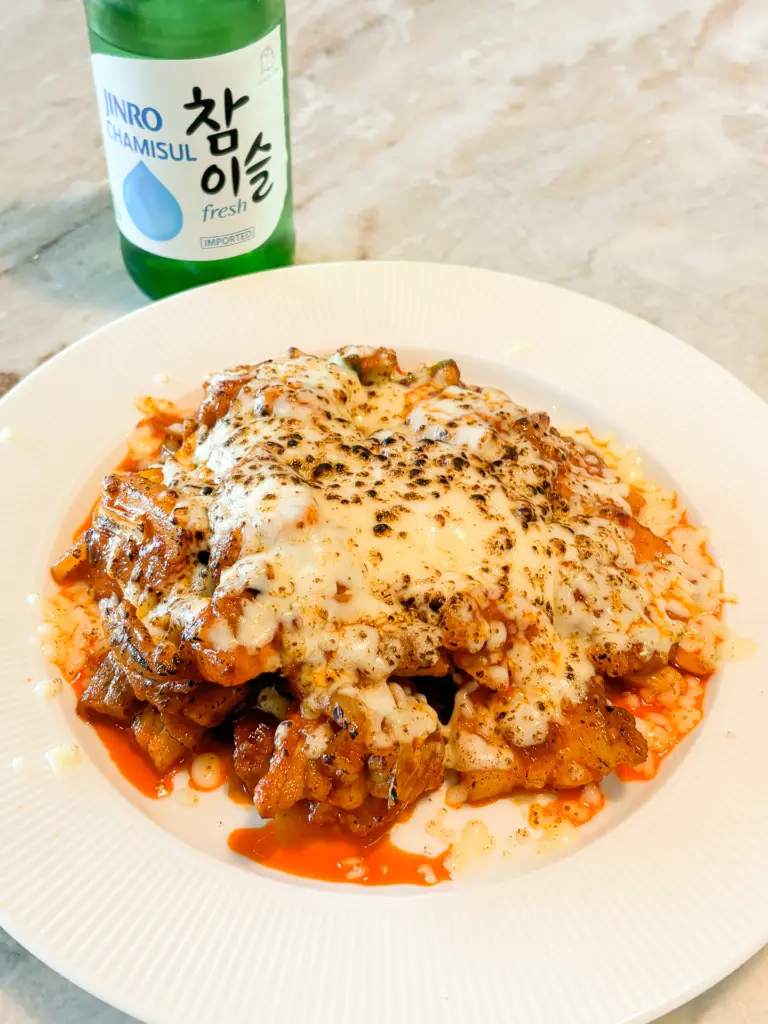
Wild Boar Jeyuk Bokkeum?
These days, pork is relatively affordable in Korea, so it’s easy to find many dishes made with pork. But back in the Joseon Dynasty, when Jeyuk Bokkeum first originated, beef was more favored and people were reluctant to raise pigs. As a result, pork was considered rare at the time. It’s even said that wild boar was used instead of domestic pork in those days.
Difference Between Pork Bulgogi and Jeyuk Bokkeum
Pork Bulgogi can be made spicy or not, depending on the marinade. The marinade can be a spicy gochujang base or a milder soy sauce base. On the other hand, Jeyuk Bokkeum is always made spicy. It uses gochujang or gochugaru (Korean chili flakes) to add heat.
Spicy Pork Bulgogi and Jeyuk Bokkeum are similar, but there’s one key difference: the amount of vegetables used. If there are fewer vegetables and the meat is grilled, it’s called pork bulgogi. If more vegetables like onions and green onions are included, it is referred to as Jeyuk Bokkeum.
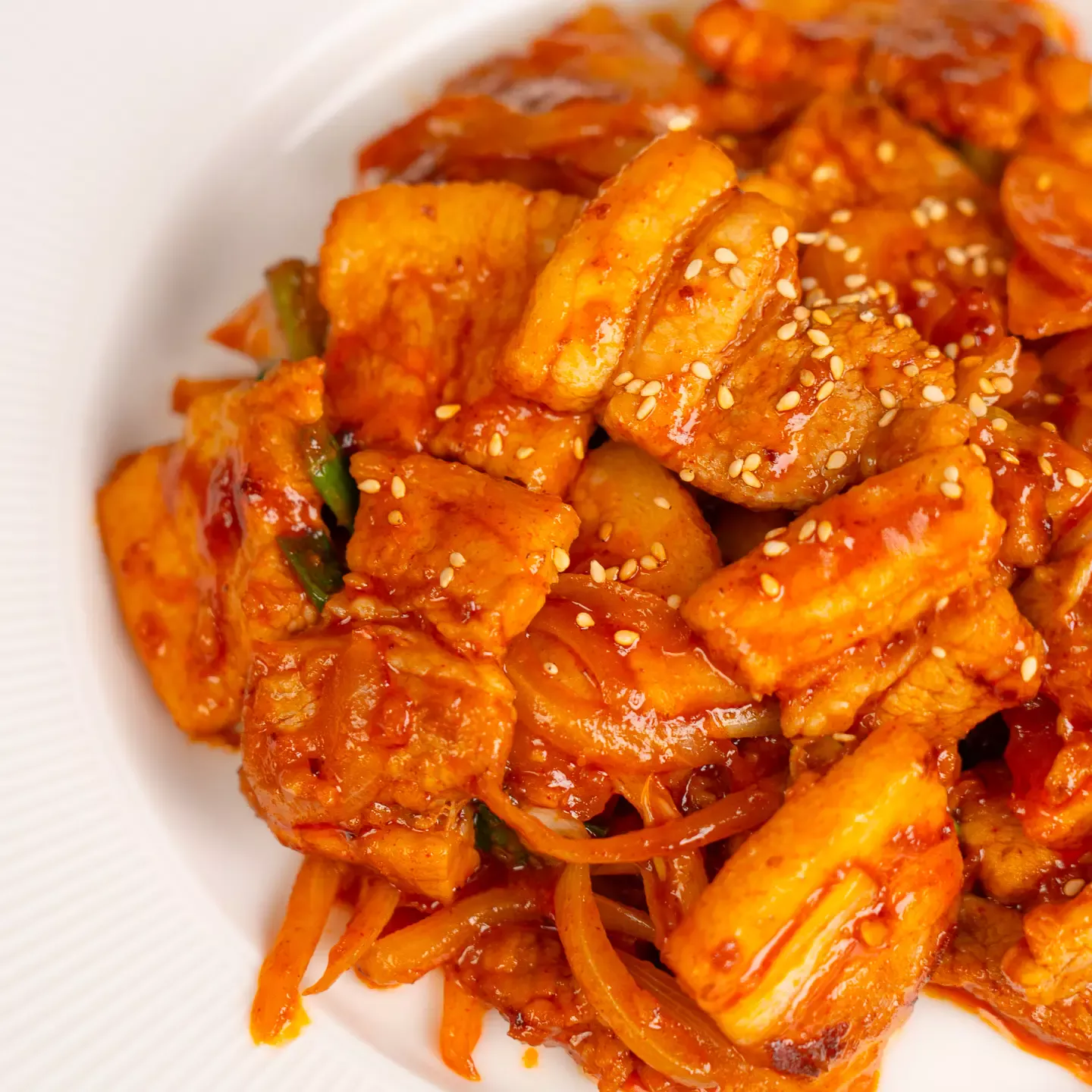
Korean Pork Recipe
There are many Korean dishes that use pork. Beef is considered a luxury ingredient in Korea, and Hanwoo (Korean native beef) is especially expensive. This is why there are so many delicious and affordable pork dishes in Korean cuisine. Let’s take a look at some of the most well-known Korean pork recipes.
Braised Kimchi with Pork (Kimchi Jjim)
You might already know about kimchi jjigae (kimchi stew), but Koreans also eat kimchi jjim a lot. It has less broth than the stew and is cooked longer, which allows the deep flavor of kimchi to blend beautifully with the rich, tender pork. Many Koreans consider this one of their favorite home-cooked meals. Below is my mom’s Kimchi Jjim recipe with pork.
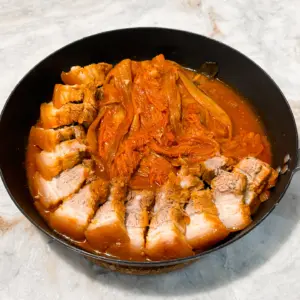
Bossam (Boiled Pork Wraps)
Bossam is made by gently boiling pork and wrapping it in vegetables like kimchi or napa cabbage. In Korea, we add various spices to remove the pork smell while cooking. But it can be difficult to find those ingredients abroad. However! Cola solves everything! It removes the porky smell and makes the meat super tender without the need for extra fruits or spices. I highly recommend the Coke Bossam recipe below.
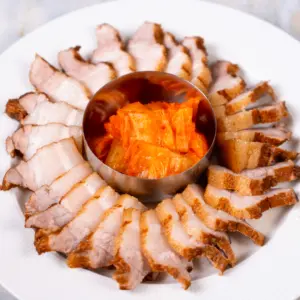
Donkatsu (Korean-Style Pork Cutlet)
Donkatsu is originally a Japanese dish, but it’s incredibly popular in Korea—especially among Korean men. Over time, Korean-style Donkatsu has evolved to be quite different from the Japanese version, from the sauce to the thickness of the meat and the way it’s fried.
The recipe below includes a Korean-style Donkatsu sauce too. This one tastes exactly like the best Donkatsu restaurants in Korea.
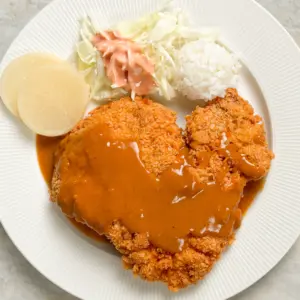
Ingredients for Jeyuk Bokkeum
Choosing the Right Cut
Koreans’ favorite cut for Jeyuk Bokkeum is samgyeopsal (pork belly), because the fattier the meat, the more tender it is. But since it’s the most popular, it’s also the most expensive cut in Korea. Every time I see how cheap pork belly is in Europe, I’m shocked.
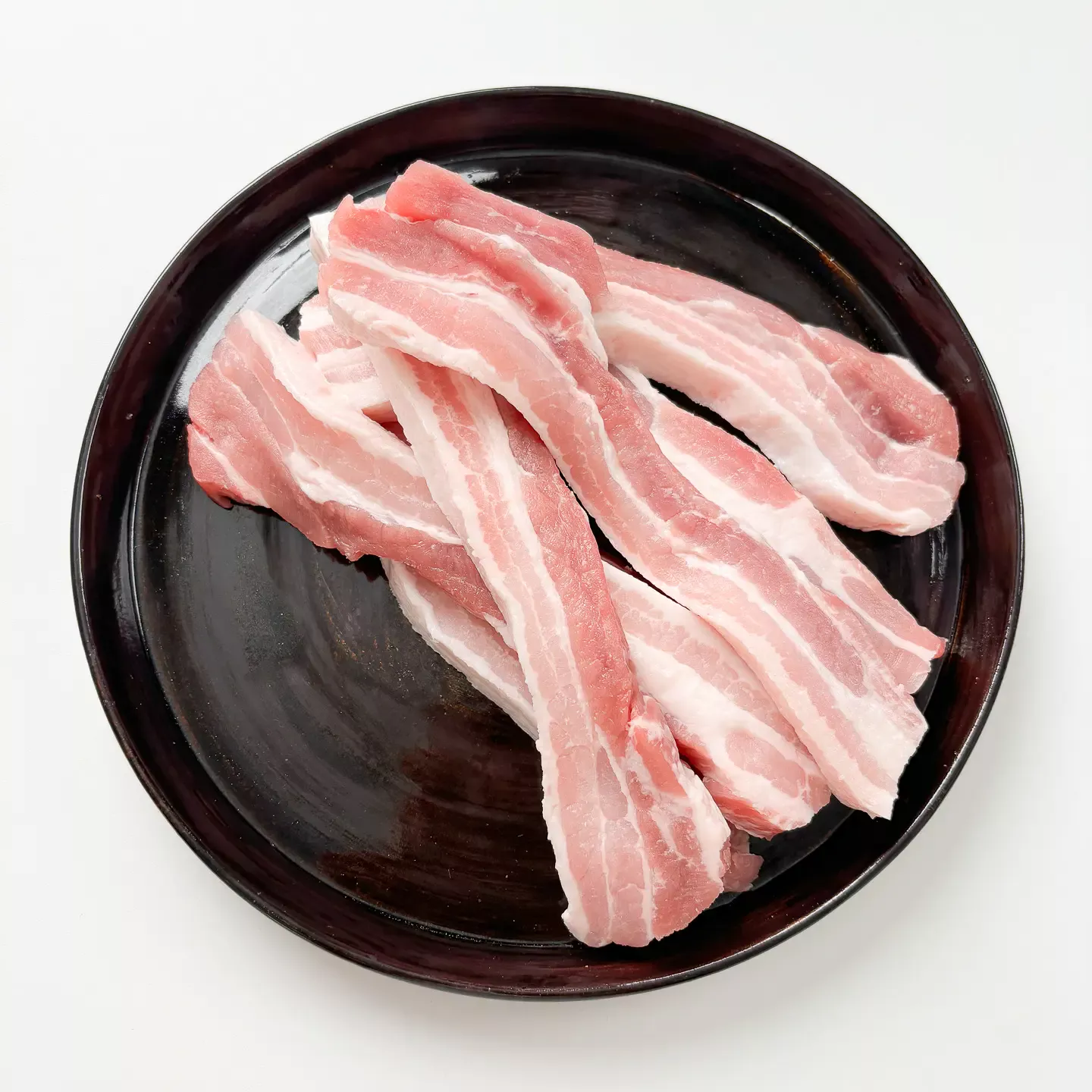
So in Korea, many people use thinly sliced pork shoulder instead, which is more affordable. It has just the right amount of fat for tenderness and a good balance of lean meat for a nice bite. You can also use pork neck or ham (hind leg) cuts.
Thin slices are ideal because they absorb the marinade better and cook faster. For pork shoulder, I recommend slices that are about 0.5 to 0.7 cm thick. For pork belly, slices thinner than 1 cm are best.
Simple Veggies, Big Flavor
Green onion and onion are key ingredients in Jeyuk Bokkeum. Some people also add carrots or cabbage. Cabbage adds a bit more moisture and makes the dish slightly more saucy.
Today, we’re keeping it simple and using only onion and green onion.
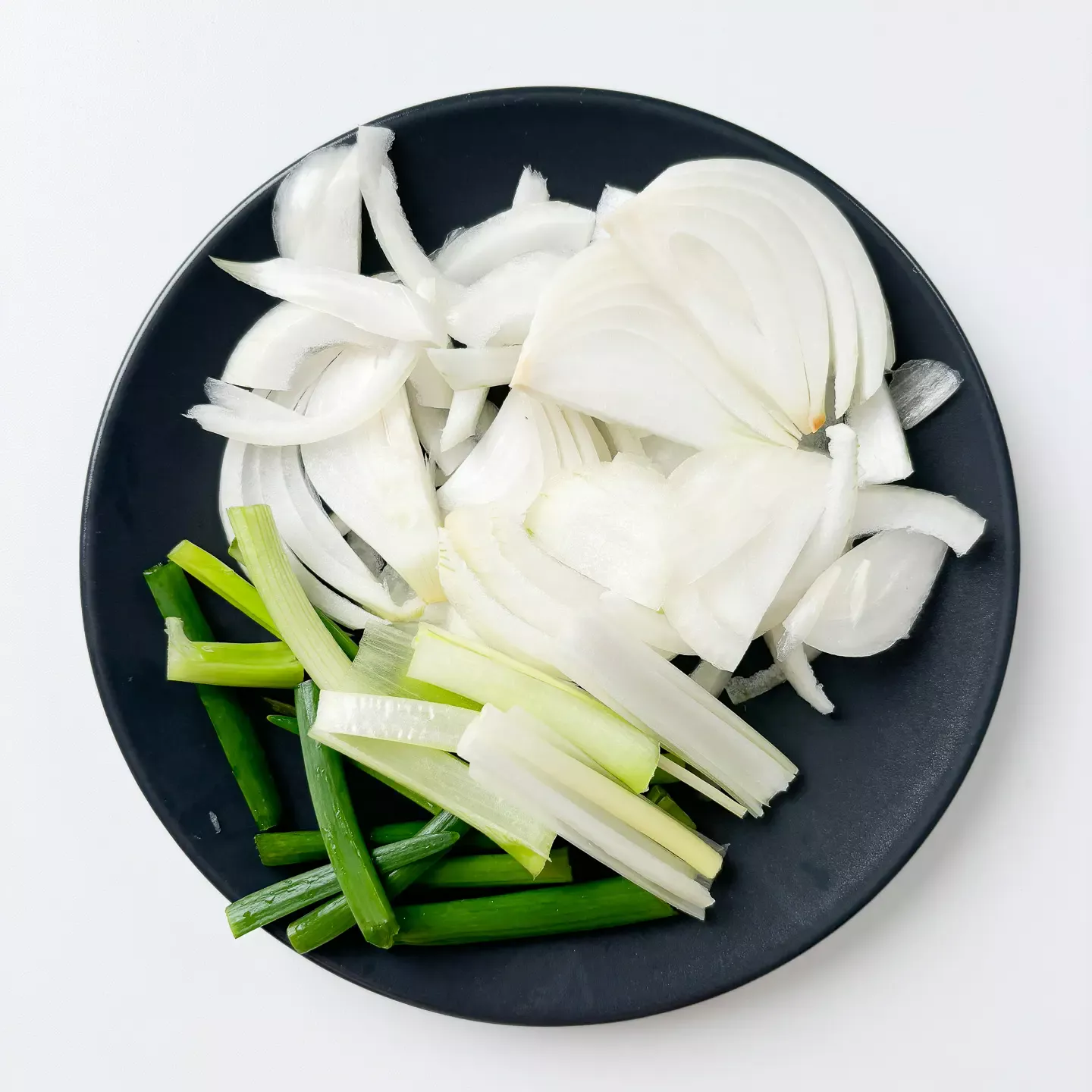
The Secret to the Perfect Marinade
The seasoning for Jeyuk Bokkeum includes a variety of traditional Korean ingredients. To make it spicy, we use gochujang (Korean chili paste) and gochugaru (Korean chili flakes). To get rid of the bad pork smell, we add cooking wine(Matsul, Mirin) and garlic.Soy sauce and oyster sauce add depth and umami, while sugar and corn syrup are added for sweetness. Corn syrup also gives the dish a nice glossy finish.
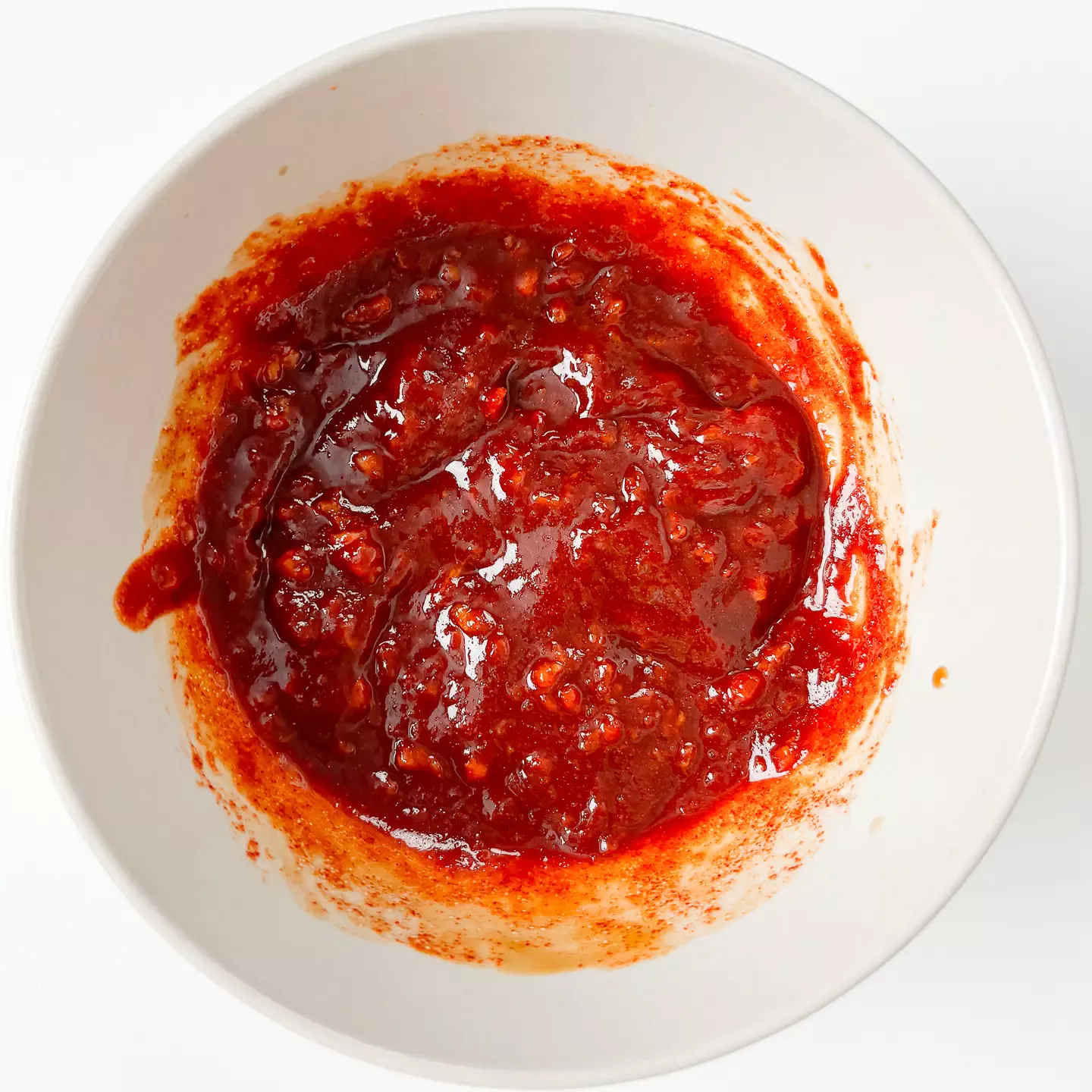
Various Jeyuk Bokkeum Recipes
There are many ways to make Jeyuk Bokkeum. Let’s look at the good and bad of each method so you can change the recipe to make it the way you like it and make a more delicious Jeyuk Bokkeum.
- Marinating the Meat in the Sauce First
One way to cook it is to marinate the pork in a gochujang sauce before stir-frying it with vegetables. This method allows the marinade to deeply penetrate the meat, resulting in a flavorful dish where the seasoning reaches all the way through the pork.
However, this method is not recommended for beginners. The meat can easily burn when placed in the pan, so it’s important to control the heat.
- Stir-Frying the Vegetables First, Then the Meat
In this method, you stir-fry green onion and onion first, allowing the flavor of the oil to absorb the fragrant onion taste and enhancing the umami.
If you like your vegetables to be soft and tender, you can sauté them first and let them soften before adding the meat. Since the seasoning is added later, the risk of burning is lower.
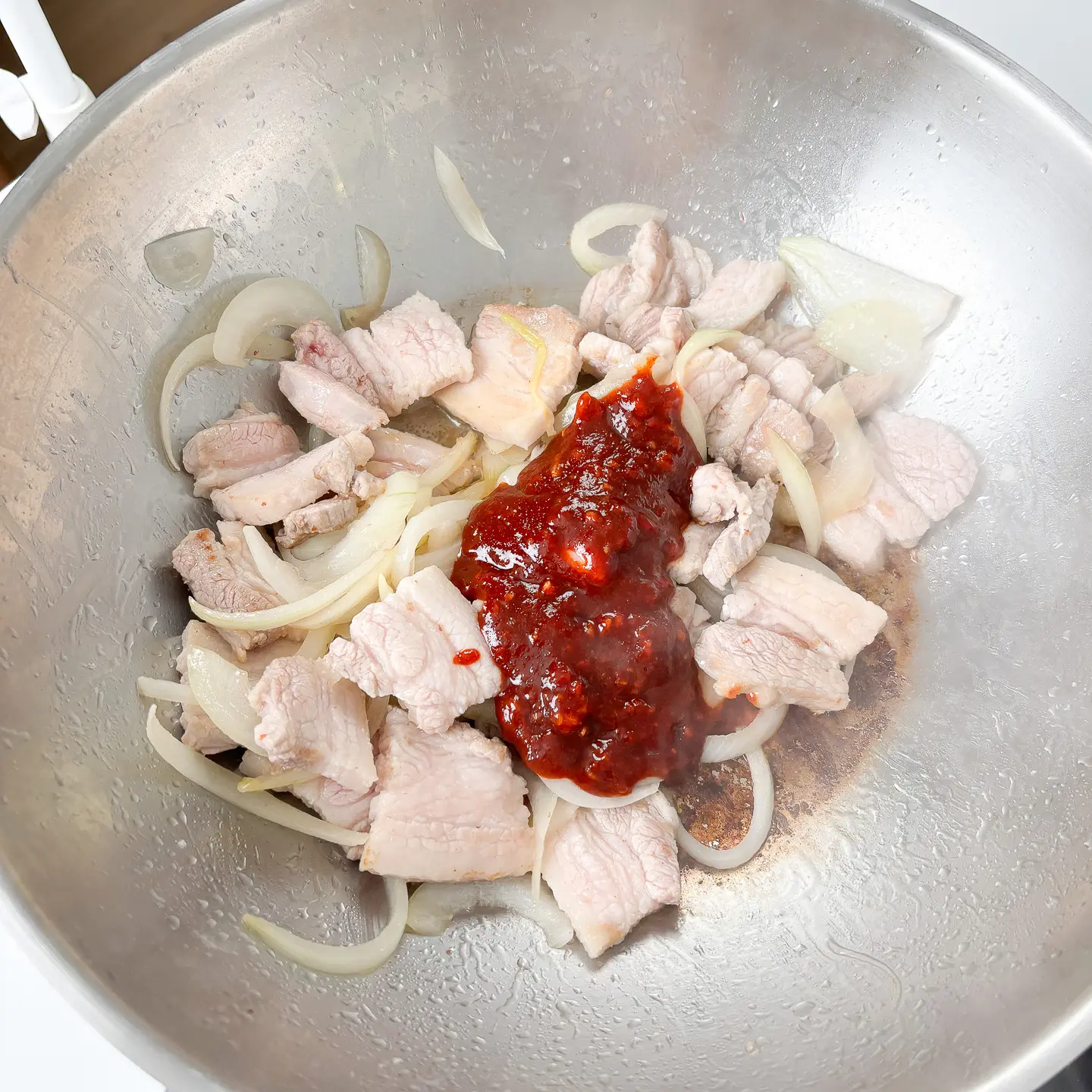
- Stir-Frying the Meat First, Then the Vegetables
Here, you stir-fry the pork first and use the fat from the meat to sauté the vegetables, which adds extra flavor to the vegetables. Also, since the vegetables are added later, they maintain a nice crunch. The seasoning is added at the end, reducing the risk of burning.
How to Prevent from Burning?
- Order of Adding the Marinade
If you stir-fry the marinated pork or cook the meat and seasoning together at the beginning, beginners are more likely to burn the marinade. To avoid this, cook the pork first and add the marinade later. This helps prevent burning.
- Heat Control
The pork is cooked on high or medium-high heat, but once the marinade is added, it’s best to switch to medium heat. This will stop the marinade from burning. If you’re an experienced cook, you can use high heat to quickly stir-fry the vegetables without releasing too much moisture. However, for beginners, medium heat is the safer option to avoid burning.
- Oil Usage
Using too little oil can cause the marinade to stick to the pan and burn. It’s better to use enough oil, or if you’re using a fatty cut like pork belly, the fat in the meat itself can help prevent sticking.
Korean Spicy Pork Belly
In Korea, there are many dishes that use spicy seasonings with pork belly. Let’s take a look at some representative spicy pork belly dishes.
- Jeyuk Bokkeum (Spicy Stir Fry Pork)
Today’s recipe is Jeyuk Bokkeum. You can use pork belly, but in Korea, it’s often made with the cheaper front leg meat (apdari-sal). This dish is stir-fried with vegetables and pork in a spicy-sweet marinade made with gochujang (Korean chili paste) and soy sauce. Sometimes gochujang is omitted, and gochugaru (Korean chili flakes) is used to adjust the thickness and spiciness. It can be eaten as a side dish with rice, or placed on top of rice to make a quick and easy Jeyuk Bokkeum rice bowl.
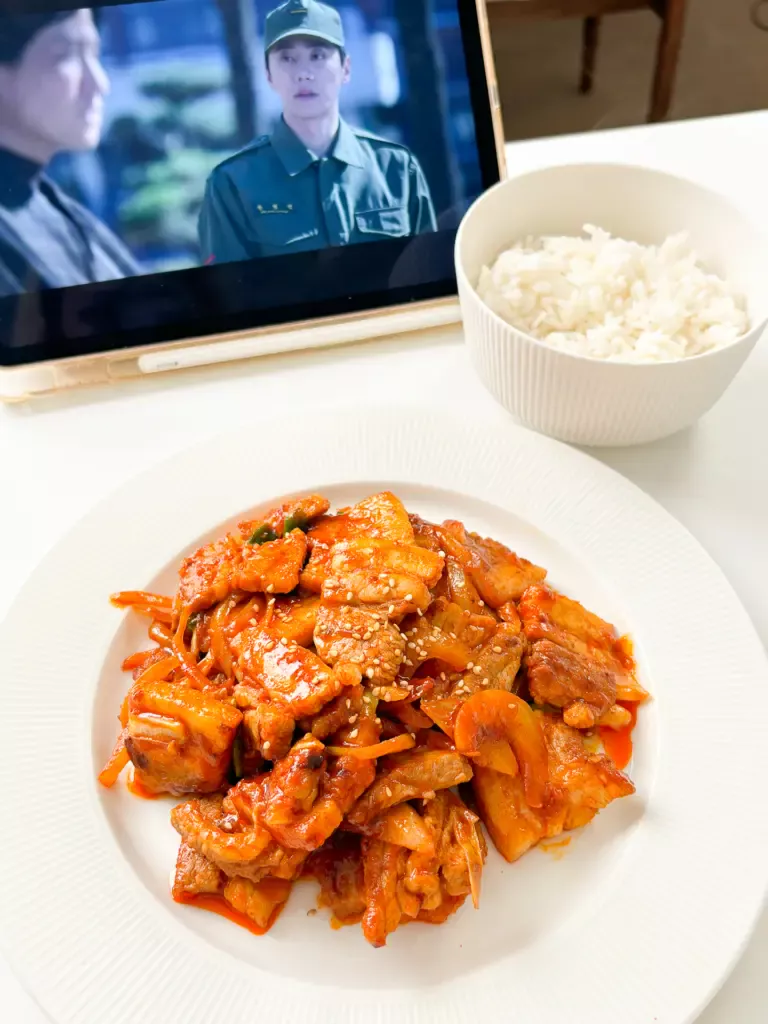
- Gochujang Samgyeopsal (Spicy Pork Belly with Gochujang)
Jeuk Bokkeum sometimes doesn’t use gochujang and uses only soy sauce or gochugaru, but Gochujang Samgyeopsal is made with a strong gochujang base, without soy sauce or with more gochujang than soy sauce, giving it a more intense spicy flavor.
- Osam Bulgogi (Stir-Fried Squid and Pork Belly)
This dish combines squid and pork belly stir-fried in a spicy gochujang marinade. There are many Korean dishes that combine seafood and meat, and the chewy squid combined with the tender pork is a perfect harmony. At the end, the dish can be mixed with rice or made into fried rice for an extra tasty treat.
- Kimchi Samgyeopsal Duruchigi (Kimchi Stir-Fried Pork Belly)
This dish is similar to Jeyuk Bokkeum, with gochujang seasoning and pork belly, but with the addition of kimchi. A little water may be added at the end to create more liquid, or it can be made without. The difference between Duruchigi and Jeyuk Bokkeum lies in the amount of liquid. Jeyuk Bokkeum is stir-fried with little to no liquid, while Duruchigi may have a bit more liquid, making it more stew-like. While both are stir-fried, Duruchigi is more like a stew with a little broth.
Substitutes for Ingredients
- Gochujang (Korean Red Chili Paste): If you don’t have gochujang, you can skip it. Instead, add more gochugaru (Korean chili flakes) and use soy sauce and oyster sauce to balance the flavor.
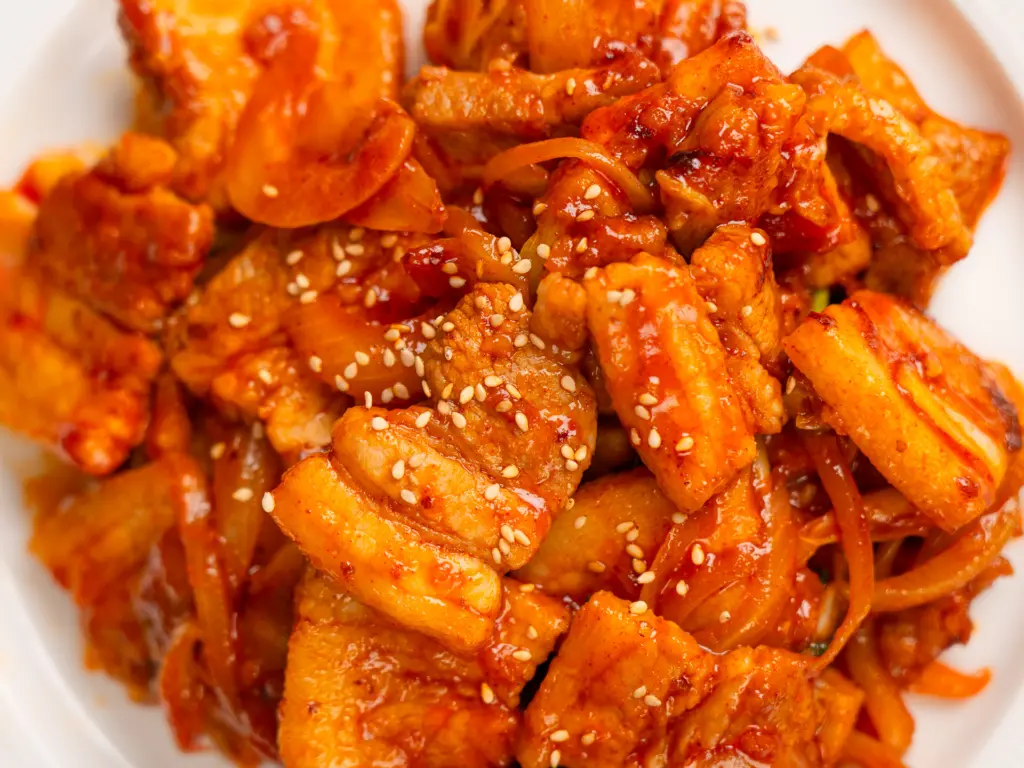
- Mirin (Cooking Wine): You can use soju or white wine instead of alcohol.
- Corn Syrup (Mulyeot): If you don’t have corn syrup, you can use a very small amount of sugar or honey as a replacement.
- Gochugaru (Korean Chili Flakes): If gochugaru is too spicy, you can replace it with paprika powder. However, you will lose the signature flavor of Jeyuk Bokkeum.
- Oyster Sauce: If oyster sauce is unavailable, simply add more soy sauce and a pinch of MSG to enhance the umami.
- Pork: Since “Jeyuk” refers specifically to pork and “Bokkeum” means stir-fry, using another type of meat technically makes it no longer Jeyuk Bokkeum. However, if you can’t eat pork, you could substitute with beef, but it’s essential to slice the beef very thin (about 1mm) to avoid it becoming tough or chewy. Also, choose a cut with some fat to ensure tenderness. When stir-frying, you’ll need to add more oil since beef generally has less fat than pork.
Get Ingredients
- Stainless Steel Wok: https://amzn.to/3DQgIPu (US), https://amzn.to/4hmr6w3 (DE), https://amzn.to/42f3uVG (NL), https://amzn.to/3RcZnmR (UK)
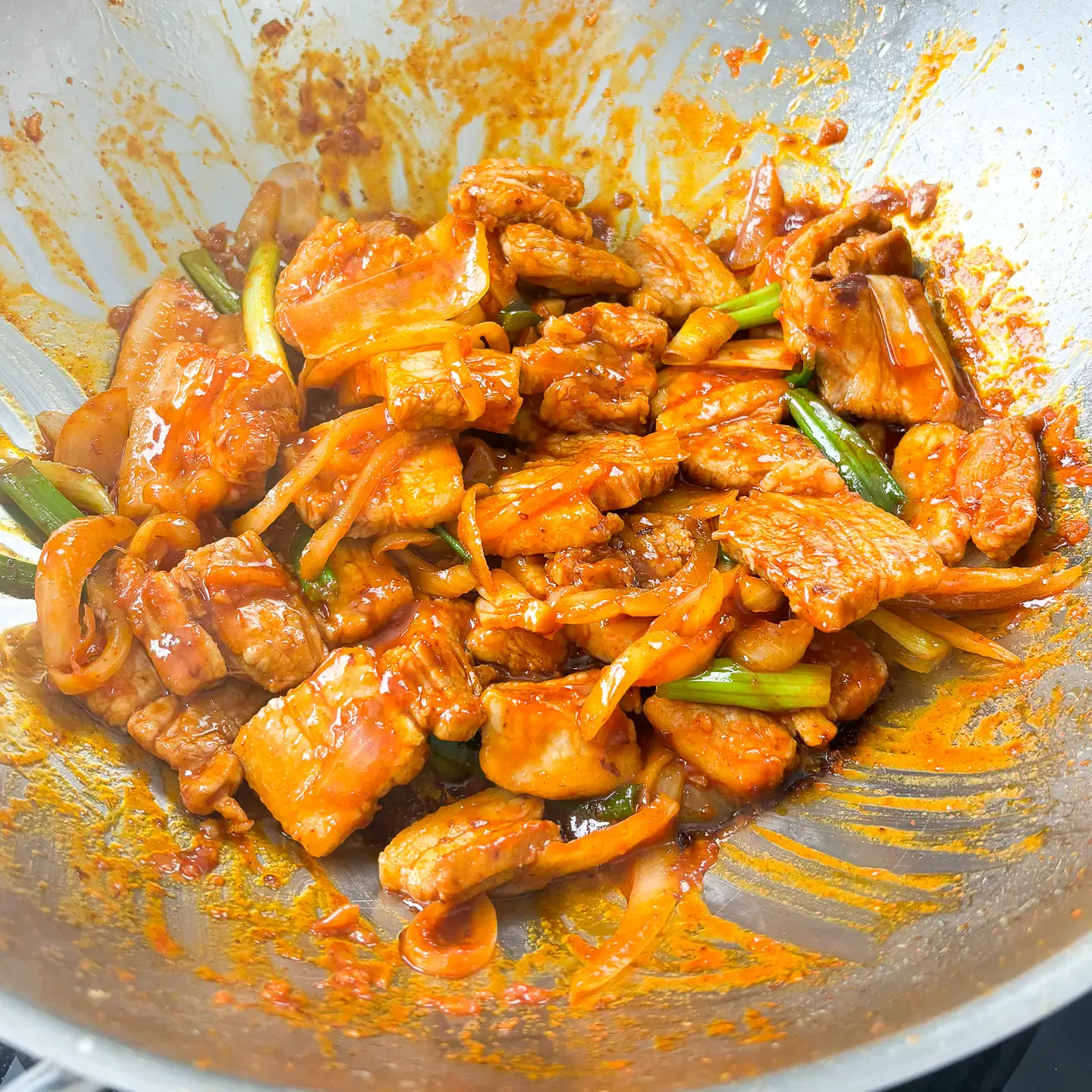
- Gochujang: https://amzn.to/3XstNFi (US), https://amzn.to/4hSoh65 (DE), https://amzn.to/4l4b2BU (NL, BE), https://amzn.to/4curibS (UK)
- Soy Sauce: https://amzn.to/4gYk1BJ (US), https://amzn.to/4gW8zGv (DE), https://amzn.to/3Ef2bgl (UK)
- Mirin or Matsul (cooking wine): https://amzn.to/3CV5tF1 (US), https://amzn.to/4hSBvAH (NL, BE), https://amzn.to/4jLJ0Kn (UK)
- Sesame seeds: https://amzn.to/3D85aXg (US), https://amzn.to/3EQVBwt (DE), https://amzn.to/3D7C6iD (NL, BE), https://amzn.to/4i6V8UL (UK)
- Rice: https://amzn.to/4bdcfCH (US), https://amzn.to/41xxThP (NL, BE), https://amzn.to/4kgVgmQ (DE), https://amzn.to/4ibBneK (UK)
- Mulyeot (corn syrup): https://amzn.to/414jWYx (US), https://amzn.to/3X3nxnh (DE), https://amzn.to/3R7CSQe (UK)
- Oyster Sauce: https://amzn.to/3Q8vjYX (US), https://amzn.to/3CI3Om4 (DE), https://amzn.to/40Oiubl (UK)
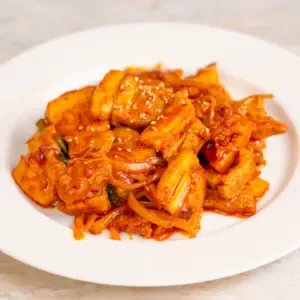
Best Korean Spicy Pork Stir Fry (Jeyuk Bokkeum) – Seoul Restaurant Style In 15 Minutes
Equipment
- 1 Cutting board & knife
- 1 Mixing bowl
- 1 wok
- 1 Spatula
- few measuring spoons
Ingredients
- 400 g sliced pork belly (thinner than 1cm)
- 1 stalk green onion
- 1/2 onion
- 1 tsp toasted sesame seeds
- 3 tbsp cooking oil
Jeyuk Bokkeum Sauce
- 1.5 tbsp gochujang (Korean red chili paste)
- 1 tbsp gochugaru (Korean red chili flakes)
- 2 tbsp Korean soy sauce (jin ganjang)
- 1 tbsp oyster sauce
- 2 tbsp Matsul or Mirin (Korean cooking wine)
- 1 tbsp sugar
- 1 tbsp Mulyeot (corn syrup)
- 1 tbsp minced garlic
Instructions
- Cut the meat into 2-3 cm.
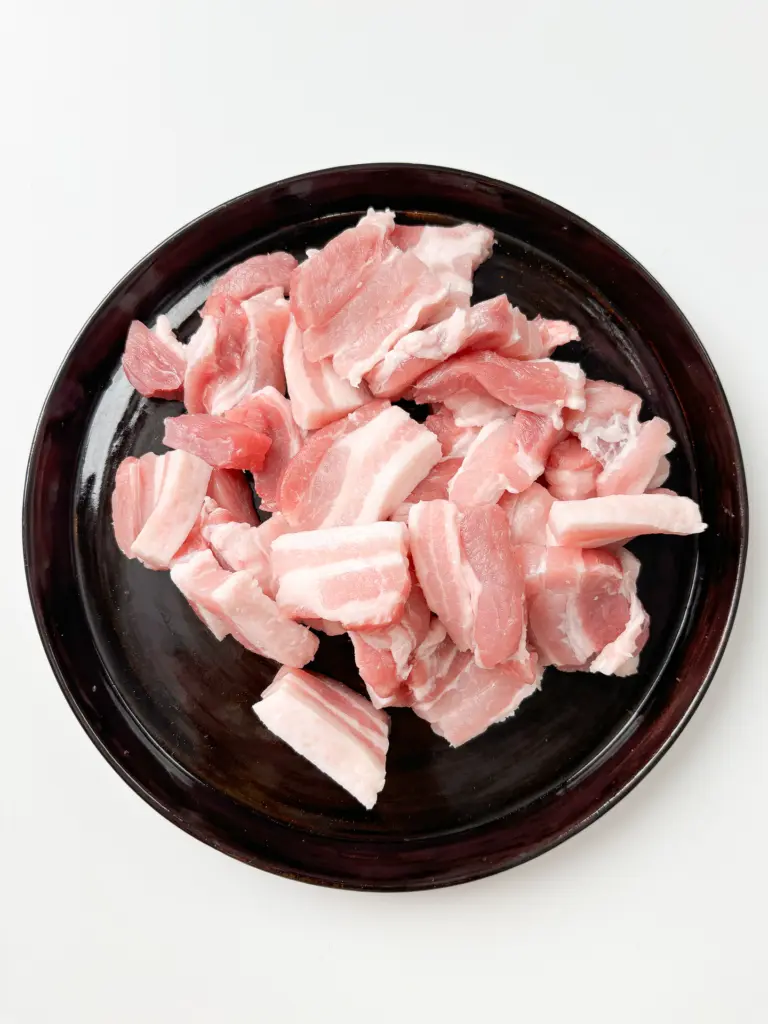
- Thinly slice the onion. Cut the green onion in half lengthwise, then cut into 3 cm (about 1 inch) pieces.
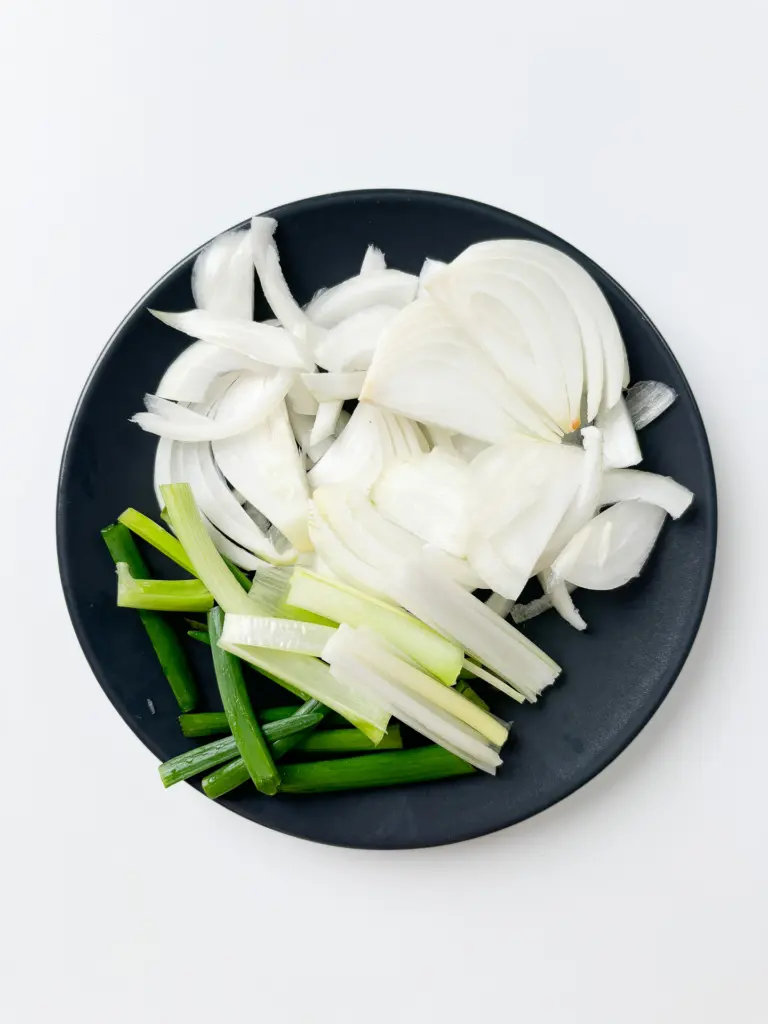
- In a bowl, mix all the sauce ingredients together: gochujang, gochugaru, soy sauce, oyster sauce, cooking wine, sugar, corn syrup, and minced garlic.
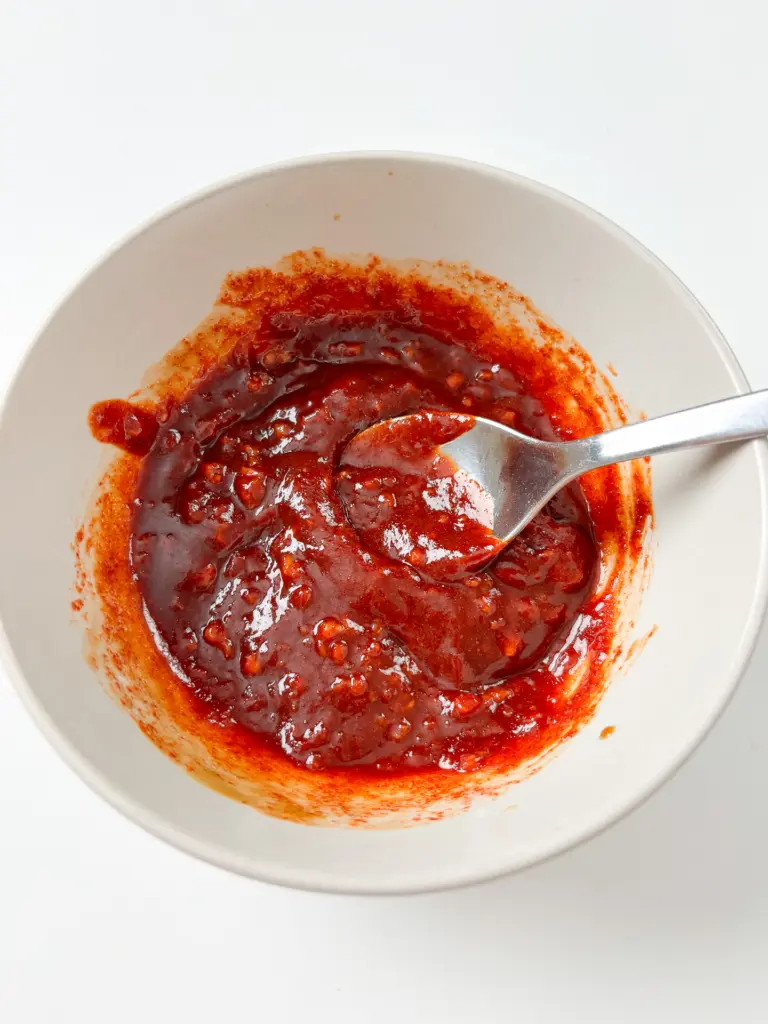
- In a wok pan, add cooking oil and stir-fry the pork and sliced onion over medium-high heat.

- When the pork is about 70% cooked and no longer pink, reduce to medium heat and add the sauce. Stir-fry until well coated and fully cooked.
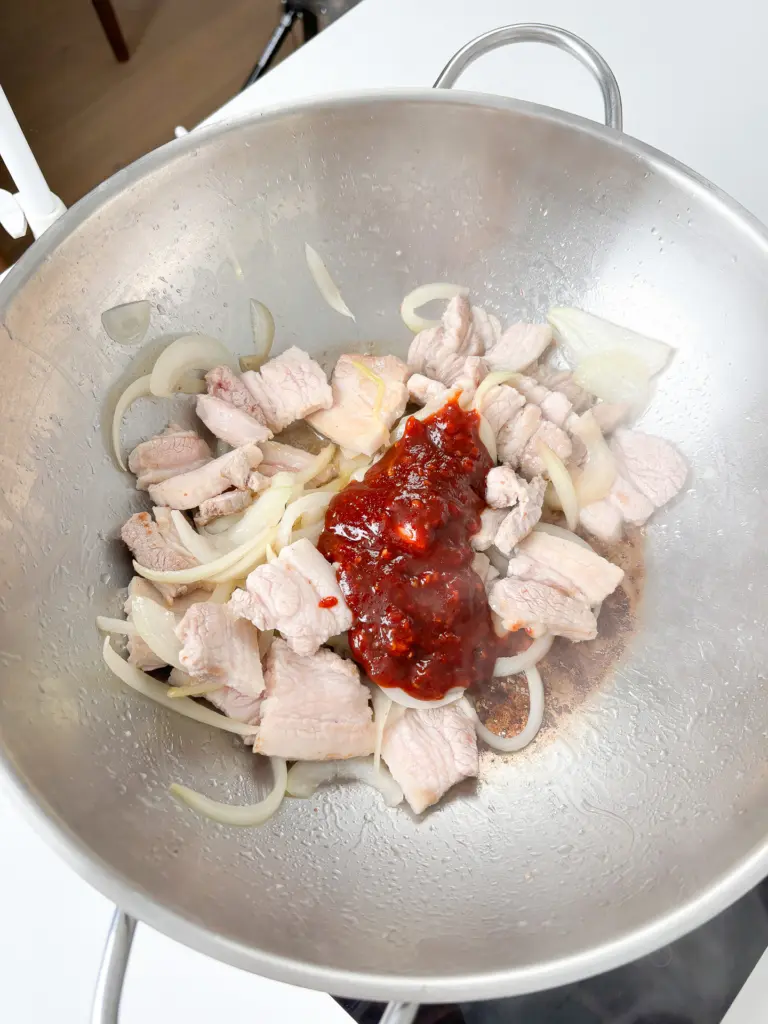
- Add the green onion and stir-fry for another 2 minutes over high heat.

- Finish with a sprinkle of toasted sesame seeds on top.
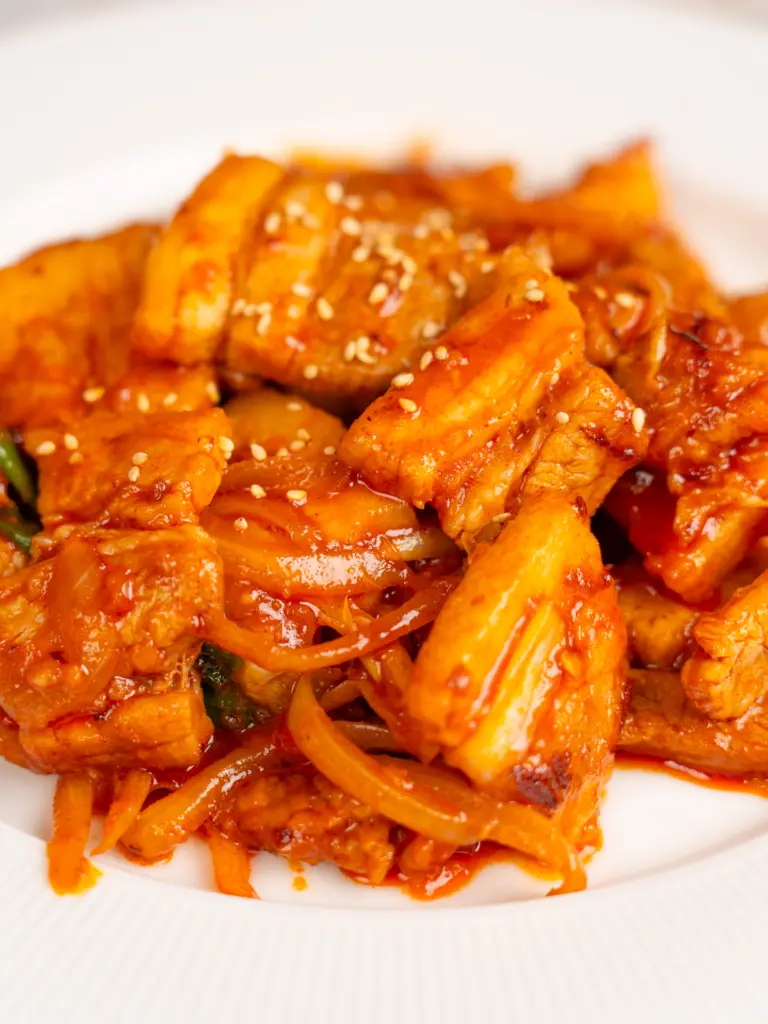
Jeyuk Bokkeum 제육볶음
- 잘 먹겠습니다! Jal meokgetseumnida!
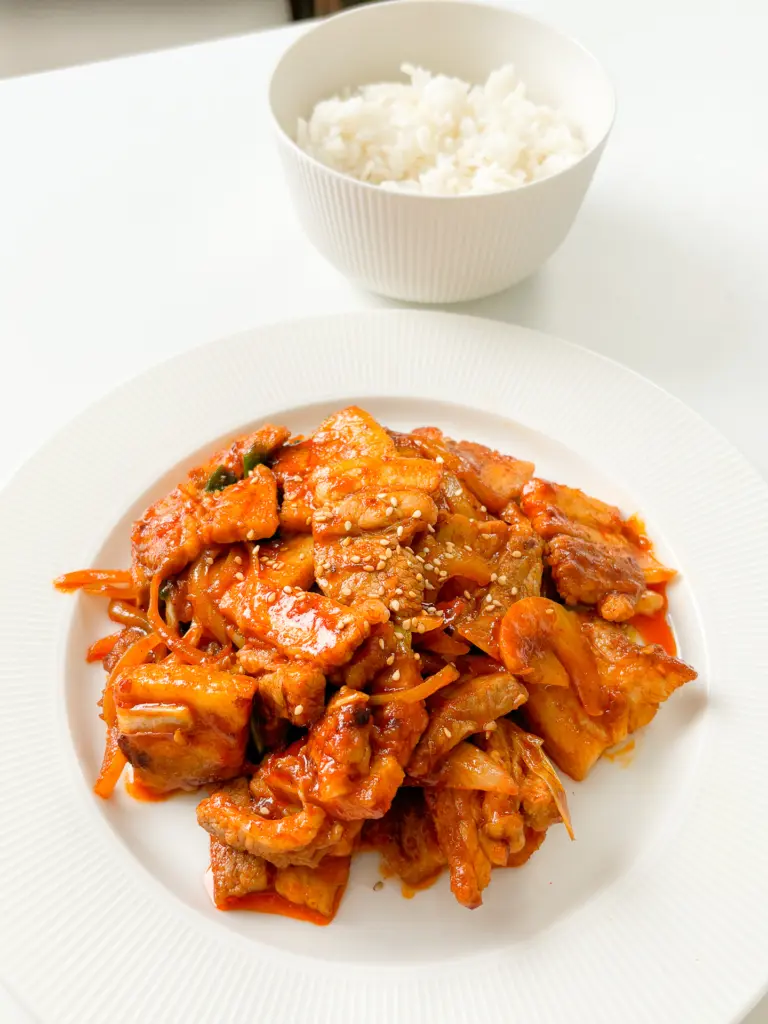
- If it's spicy, you can add some cheese on it! Enjoy!

Did you make this recipe?
Please let me know how it turned out for you! Leave a comment below and tag @blondekimchi_ on Instagram and hashtag it #blondekimchi.
